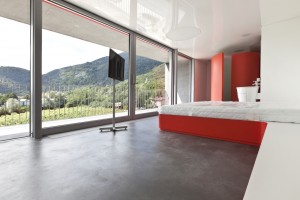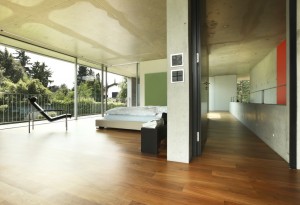The first step toward a sustainable lifestyle is the one you take through your front door. The simplest (and arguably most important) way to make a positive impact on the environment is in your home. From your daily routines to major projects, sustainability can be incorporated into every footprint you make.
As someone who strives to live sustainably, I was eager to reduce, reuse and recycle when remodeling a converted garage into our master bedroom. The biggest component of any remodel is the flooring, plus it comes with the largest carbon footprint. Whether you choose hardwood, tile or carpet, you are consuming natural resources, and, if you’re not careful, contributing considerable amounts of chemicals and other pollutants to the planet. So what is a sustainable homeowner to do? Consider concrete.


If you’re converting a garage, basement or ground floor space, the chances are you already have concrete sub-flooring right there, ready to go. When I peeled back the decades-old carpet from my converted garage flooring, I was thrilled to find concrete. The perfect solution, I thought. No need to bring in new materials; just polish this up and voila, a new floor.
However, my husband wanted hardwood. So began a deep and detailed dive into the environmental and practical pros and cons of concrete versus hardwood flooring. What I discovered surprised me, and made me realize the importance of thinking through every element of sustainability — not just the obvious ones — when making choices with green living in mind.
Longevity – WINNER: Concrete
With proper care, solid hardwood floors should last for over fifty years, but, unless you take a jackhammer to it, concrete will likely outlive you, your kids, and their children.
Durability – WINNER: Hardwood
There are three distinct types of hardwood floors: solid hardwood, engineered hardwood and laminate (which is not wood at all). We focused on solid hardwood for our project. Solid hardwood is very tough, but it’s not indestructible. However, scratches can often be buffed out or colored in, and down the road the floor can be refinished to look like new. On the flip side, there really isn’t much harm you can do to concrete, but it can harm you. Common complaints about concrete flooring include fatigued joints and sore feet from walking on it all day. Additionally, if you have small children, a fall off the bed could easily result in a trip to the emergency room.
Aesthetic Appeal – WINNER: It’s a tie
It is hard to beat the classic beauty of solid hardwood floors, and it’s easy to match to your décor. If you’re picturing the concrete you find in a warehouse when you think of concrete floors, think again. The application of acid-stains, stenciling, painting and other creative techniques to concrete can create a truly unique look; nearly everyone has hardwoods, but not many people have intricately painted concrete floors. Concrete can be any color you like, and can be made to look like marble, granite or even hardwood. However, a lot of these options greatly increase the price.
Energy Efficiency – WINNER: It’s a tie
The cellular structure of wood traps air, giving hardwood floors superior insulating properties. It takes 15 inches of concrete to equal the insulation qualities of just 1 inch of wood. However, concrete will naturally absorb heat from the sun in the winter and stay cool in the summer, keeping energy costs down. Polished concrete floors will also reflect light, keeping your room bright and reducing the amount of lighting needed during the day.
‘Cradle to Grave’ Credibility – WINNER: Concrete, if it’s in place. Hardwood, if new. you are starting from scratch.
Hardwood floors come from trees, obviously. However, responsibly sourced wood, certified by the Forest Stewardship Council and from sustainable forests, is one of the greenest options for flooring. Some products in the hardwood family, such as bamboo and cork, are easily renewable resources; bamboo is denser than oak and as stable as some maple and pine species, and cork is extremely durable and resistant to moisture. The manufacturing process of hardwood floors is cleaner than that of concrete, which results in up to six times more pollutants and over three times as much carbon monoxide. However, those figures are nullified if you are using concrete already in place versus buying new hardwood. Both concrete and hardwood are fully recyclable, although the energy expended to remove concrete affects the benefits of recycling.
Price – WINNER: Hardwood, but that can depend on the individual project.
The price of natural hardwood depends on the tree. The most expensive hardwood comes from mahogany, wenge and teak. The softest hardwood used in flooring is pine, which is relatively inexpensive. With concrete you are likely to never replace it, so your savings are part of a long-term investment, but it does cost to install. A professional will finish the sub-floor and apply premium stains or etchings to the concrete that can cost up to about $17 per square foot.
Maintenance – WINNER: Concrete
As this 16-step guide to cleaning your hardwood floors implies, hardwood does require regular, detailed and careful maintenance, whereas polished concrete floors are incredibly easy to care for: just dust and mop. Polished concrete floors are non-porous, so they don’t trap mold, mildew, dust mites, bacteria, allergens or moisture.
We really went back and forth over this decision. I loved the idea of flooring that didn’t require any new materials to be manufactured, but from an aesthetic standpoint, we already had hardwood in the house and the continuity was a strong argument against concrete. Additionally, after researching both options thoroughly, I realized that, as long as we are careful in our choice, hardwood floors are far more eco-friendly than I had originally believed. The longevity and insulating properties of hardwood, combined with the sustainable practices of ethical manufacturers, offsets the carbon footprint of its manufacture – especially compared to concrete. Overall, this exercise really opened my eyes to how important it is to scratch below the surface of sustainability in order to make truly informed decisions about how to best help the planet in your daily life.
Jennifer Tuohy writes about green homes and sustainability for Home Depot. Many of the wood flooring types mentioned in Jennifer’s article can be viewed on the Home Depot website.